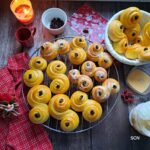
Lussekatter or Swedish Saffron buns
Lussekatter, also known as St. Lucia buns, are traditional Swedish saffron-infused sweet buns shaped into various forms, commonly associated with the St. Lucia Day celebration on December 13. Their vibrant golden colour comes from saffron, and they’re typically decorated with raisins, making them a festive treat enjoyed during the holiday season.
Ingredients
- 0.5 g saffron threads
- 250 ml whole milk
- 100 gms of butter melted
- 80 gms of sugar
- 1 packet 7g instant dry yeast
- 500-550 gms of all-purpose flour
- 1 tsp salt
- 1 egg
- 2 tbsps of Raisins for garnish
- For brushing
- 1 egg
- 1 tbsp water
- Sugar syrup
- ¼ cup sugar
- ½ cup water
- Butter glazed optional
- 2-3 tbsp melted butter
- ¼ cup sugar
Instructions
- Crush the saffron threads, soak the raisins in warm water and keep them aside.
- Melt the butter in a saucepan over low heat. Once melted, add the milk and heat the mixture until it's lukewarm (around 37°C). This helps the yeast activate without scalding it.
- Pour the lukewarm mixture into a large bowl or a stand mixer bowl.
- Add the sugar, yeast, egg and crushed saffron.
- Let it sit for about 5–10 minutes until the yeast activates and becomes foamy. This step is optional if you are using instant dry yeast.
- Mix salt into the 500 grams of flour into the liquid mixture and start kneading. Add 1 tablespoon of more dough at a time and knead until a smooth dough forms. The dough should be soft but not sticky.
- Transfer it to an oiled bowl and let it rise for about an hour until doubles in size.
- After the dough has risen, punch it down and roll it out into a uniform rectangle, about ¼ inch thick. Aim for even thickness throughout, which helps ensure consistent baking.
- Using a pizza cutter, cut the dough into approximately 16 strips that are about 1 inch wide. Try to keep the strips uniform in width to make each bun similar in size and shape.
- Take one strip and start rolling it tightly from one end, coiling it toward the centre. When you reach the middle of the strip, stop rolling. Then, turn the strip around and roll from the other end toward the centre, creating an "S" shape with the two spirals facing opposite directions.
- Keep the dough covered with a damp cloth or plastic wrap during the resting and shaping stages to prevent a dry outer layer.
- Repeat the same for all the strips.
- Place the soaked raisin or currant in the centre of each spiral on both ends of the "S."
- Arrange the shaped buns on a baking sheet lined with parchment paper, cover them lightly, and let them rise again for about 30 minutes before baking.
- This shaping method gives each Lussekatt a beautiful, symmetrical “S” shape and lets the spirals hold their shape well as they bake. Place a raisin in each curl.
- Let the buns rise for another 30 minutes until they’re puffy. This final proofing step will make the buns light and fluffy after baking.
- Preheat the oven to 220°C. Brush the buns with a beaten egg for shine, then bake for 8–10 minutes or until golden.
- For an extra moisture boost, brush the freshly baked buns with a light sugar syrup or melted butter. This adds a touch of sweetness and helps seal in moisture. However, this is optional.
Sugar syrup
- For lussekatter, sugar syrup can be brushed on after baking to give them a lovely sheen and slight sweetness.
- In a small saucepan, combine the sugar and water.
- Heat over medium heat, stirring occasionally, until the sugar dissolves completely.
- Once dissolved, bring the syrup to a gentle boil, then remove from heat.
- Let the syrup cool slightly, then brush it over the warm lussekatter just after they come out of the oven for a shiny, sticky finish.
Lussekatter with a Buttery Sugar Coated Twist
- Alternatively, Brush the lussekatter with melted butter and then roll them in sugar for a sweet and soft coating.
- Melt 2-3 tablespoons of butter.
- Once the lussekatter are out of the oven and slightly warm, brush each one generously with melted butter.
- Roll the buttered lussekatter in a plate of granulated sugar, making sure to coat all sides evenly.
- This will give them a delightful sugary crust and an extra bit of sweetness!
- Enjoy your freshly baked saffron buns!
- Lussekatter is best enjoyed fresh, often with coffee or glögg (Swedish mulled wine).
Notes
If using active dry yeast, proof it in warm milk (around 37°C) with a bit of sugar to activate it before adding to the flour. Instant yeast can be mixed directly with the flour.
Add just enough flour for a soft, slightly tacky dough. Over-flouring will make the dough dense and dry. If the dough is a bit sticky, lightly flour your hands instead of adding more to the dough.
Knead the dough until it’s smooth, soft, and elastic. This develops the gluten and creates a better structure in the buns.
Over-baking will dry out the buns. Bake just until golden brown on top. They should be soft to the touch and sound hollow when tapped on the bottom.
Once they're cool, store them in an airtight container to keep them soft. They can also be frozen and reheated gently before serving.